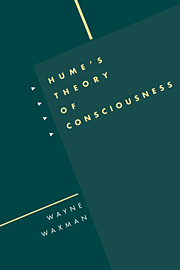Book contents
- Frontmatter
- Contents
- Preface
- Abbreviations
- Introduction: A false reason or none at all
- Part I The elements of Hume's philosophy
- 1 Impressions and ideas
- 2 Imagination and the vivacity of ideas
- 3 Words and measures
- Part II The cement of the universe
- Part III Vulgar fiction and philosophical fallacy
- Conclusion: The Cartesian nightmare come true
- Notes
- Bibliography
- Index
2 - Imagination and the vivacity of ideas
Published online by Cambridge University Press: 11 September 2009
- Frontmatter
- Contents
- Preface
- Abbreviations
- Introduction: A false reason or none at all
- Part I The elements of Hume's philosophy
- 1 Impressions and ideas
- 2 Imagination and the vivacity of ideas
- 3 Words and measures
- Part II The cement of the universe
- Part III Vulgar fiction and philosophical fallacy
- Conclusion: The Cartesian nightmare come true
- Notes
- Bibliography
- Index
Summary
The originality of Hume's conception of imagination
Imagination is the focal point of Humean psychology. It is the seat of principles “which are permanent, irresistible, and universal … the foundation of all our thoughts and actions, so that upon their removal human nature must immediately perish and go to ruin” (T225). Without imagination, there would be only “those perceptions, which are immediately present to our consciousness” (T265); there would be neither activity nor connection, no “compounding, transposing, augmenting, or diminishing the materials afforded us by the senses” (EII.13), and no idea could acquire the vivacity/verisimilitude of belief. If perceptions happened not “to strike upon the mind, and make their way into our thought or consciousness” together, there would be nothing that could unite them (nor, conversely, if they occurred together, could they be separated). Imagination is the bridge which alone enables us to pass from the self-less, object-less flux of disjointed perceptions and unvivified ideas of the senses (immediate consciousness) to the world of objective order and regularity, minds and bodies, and well-founded belief and inference. The imagination is our self, its pespective our own (“the present situation of the person is always that of the imagination,” T430; see T261). The subjectless flux of perceptions before immediate consciousness is, by contrast, an alien world into which we cannot venture without literally leaving our selves behind.
- Type
- Chapter
- Information
- Hume's Theory of Consciousness , pp. 58 - 84Publisher: Cambridge University PressPrint publication year: 1994



